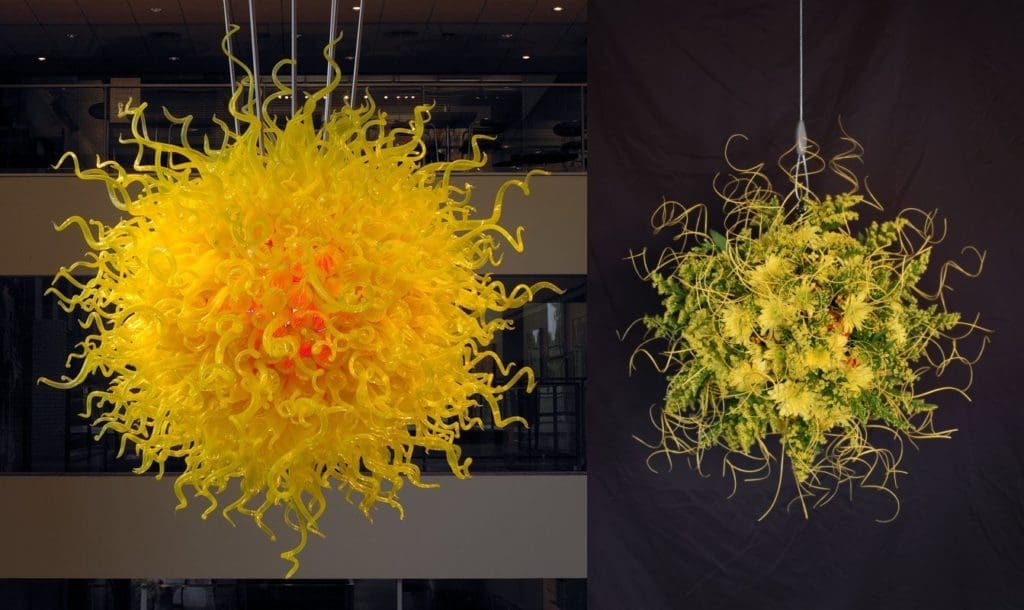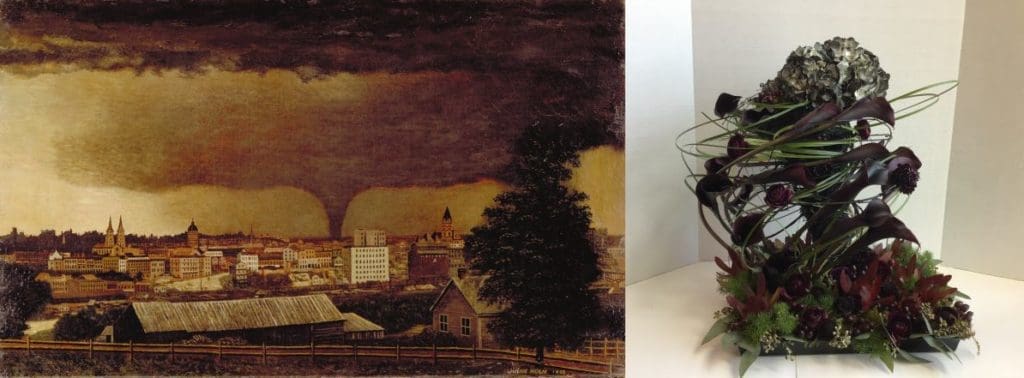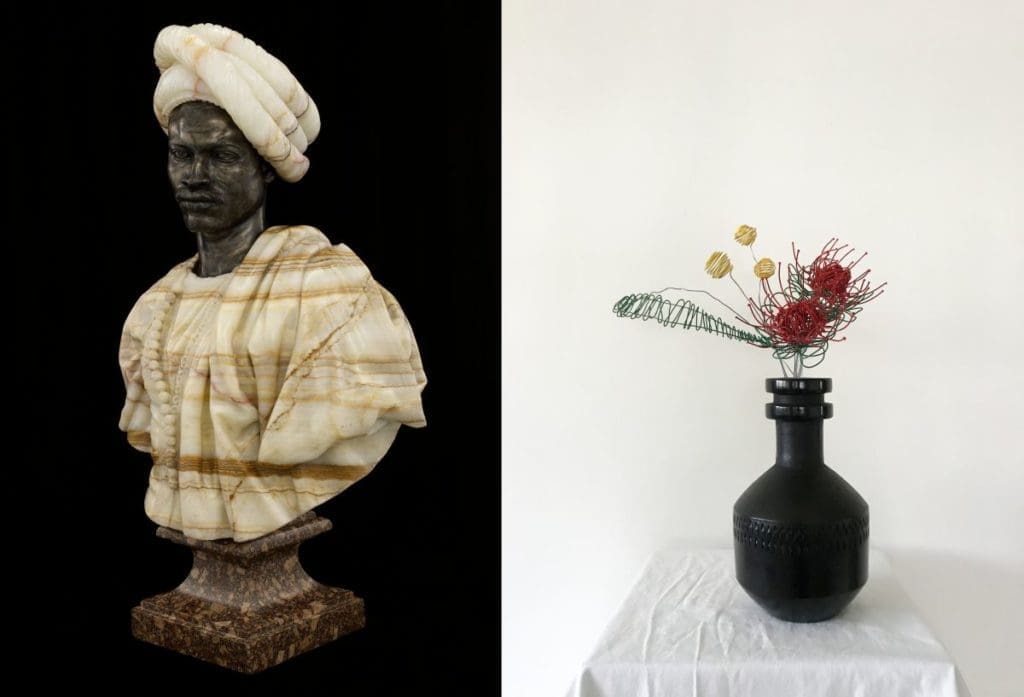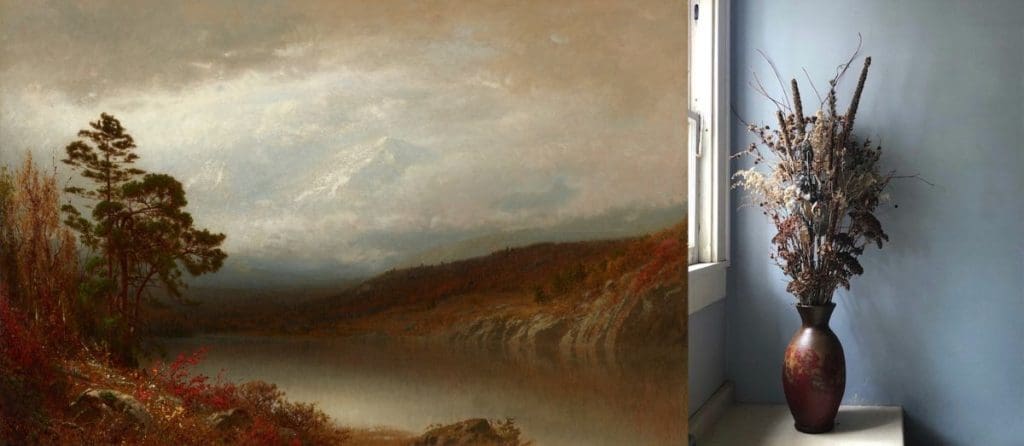Every year, Art in Bloom at the Minneapolis Institute of Art invites all kinds of creatives to participate in the weekend-long celebration, including acclaimed floral designers, florists, art enthusiasts and more. Mia enlisted these 6 creatives to craft floral arrangements inspired by their favorite works of art in the museum from the comfort of their homes.

Dale Chihuly (United States, 1941), “Sunburst,” 1999, blown glass, neon, metal armature. Gift of funds from Donna and Cargill MacMillan Jr., 99.132, © 2019 Chihuly Studios/Artists Rights Society (ARS), New York; Interpretation by Esther Stoy, John Stoy, and Suzanne Stoy
“Sunburst”
“The warm feeling that ‘Sunburst’ evokes is exactly what inspired the floral arrangement my parents and I decided to create. The beautifully delicate characteristics of the yellow flowers mirror the fragility of the suspended glass arrangement.” –Esther Stoy, John Stoy and Suzanne Stoy

Julius Holm (United States, 1855–1930), “Tornado Over St. Paul,” 1893, oil on canvas. The Ethel Morrison Van Derlip Fund, 77.28; Interpretation by Karen Ortiz, Lakeville Hy-Vee
“Tornado Over St. Paul”
“The black cone of grapevine provides the base for this floral design with the dark calla lilies and bear grass creating movement and the feeling of a spinning tornado. Ranunculus, scabiosa, leucadendron and hypericum all represent the darkness of the twister. A fluffy white hydrangea is the only element sprayed black to represent the dark cloud.” –Karen Ortiz, Lakeville Hy-vee

Charles-Henri-Joseph Cordier (France, 1827–1905), “The Algerian,” 1850–57, silvered bronze, Algerian jasper, porphyry. The William Hood Dunwoody Fund, 76.3; Interpretation by Amy Kubas using 17-gauge fencing wire, spray paint and ceramic vase
“The Algerian”
“Since the flowers I had chosen were not available from my providers, I decided to create an abstract wire sculpture creation of pincushion proteas, craspedia and a ti leaf.” –Amy Kubas

Rihei (Japan, 15th–16th century), “Ewer,” 15th–16th century, bronze. Mary Griggs Burke Collection, Gift of the Mary and Jackson Burke Foundation, 2015.79.435; Interpretation by Jodie Rodne
“Ewer”
“All the floral material is from dried arrangements I had around my house and my garden.” –Jodie Rodne

Alexander Wyant (United States, 1836–1892), “Autumn in the Adirondacks,” 1872–1873, oil on canvas. The Siri and Bob Marshall Endowment for American Paintings, 2018.23.1; Interpretation by Abbie Baldwin
“Autumn in the Adirondacks”
“I foraged materials from a park to make my arrangement. It was dropping seeds all over my house, so I wouldn’t have been able to use them if we were displaying our pieces in the museum. I guess I lucked out!” –Abbie Baldwin

Unknown (Japan), “Amida, the Buddha of Infinite Light,” 12th century, Japanese cypress with polychrome and gold. Mary Griggs Burke Collection, Gift of the Mary and Jackson Burke Foundation, 2015.79.256a-c; Interpretation by Becky Haaf
“Amida, the Buddha of Infinite Light”
“My arrangement is an interpretation of ‘Amida, the Buddha of Infinite Light.’ There are strong, simple lines — the three Fuji mums represent the ground, heart and crown chakras. The vase is handmade by Clay Panther Ceramics.” –Becky Haaf
This article is published in collaboration with the Minneapolis Institute of Art.


